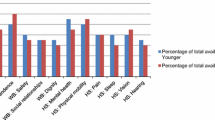Abstract
The Schedule for the Evaluation of Individual Quality of Life allows individuals to nominate the domains they consider most important to their quality of life and to use their own value system when describing the functional status and relative importance of those domains. The weights for domain importance are derived through a procedure called judgement analysis. As judgement analysis is impractical for individuals with cognitive impairment and in many clinical situations, a shorter, direct weighting procedure has been developed. To test the new procedure, 40 healthy individuals completed both direct and judgement analysis weightings, at t1 and 7-10 days later (t2). After a further 7-10 days (t3), they were asked to identify the weight profiles they had previously produced using each method. The weights produced by the two methods differed on average by 7.8 points at t1 and 7.2 points at t2. The direct weights changed on average by 4.5 points from t1 to t2, while the judgement analysis weights changed by 8.4 points. At t3, 55% of individuals were able to identify the direct weights they had previously produced. The new procedure demonstrates stability and validity but is not interchangeable with judgement analysis. The most appropriate ways of using and interpreting both procedures are discussed.
Similar content being viewed by others
References
Jenkins CD. Assessment of outcomes of health intervention. Soc Sci Med 1992; 35: 367-375.
McGee HM, O'Boyle CA, Hickey A, O'Malley KM, Joyce CRB. Assessing the quality of life of the individual: the SEIQoL with a healthy and a gastroenterology unit population. Psychol Med 1991; 21: 749-759.
O'Boyle CA, McGee HM, Hickey A, O'Malley KM, Joyce CRB. Individual quality of life in patients undergoing hip replacement. Lancet 1992; i: 1088-1091.
Browne JP, O'Boyle CA, McGee HM et al. Individual quality of life in the healthy elderly. Qual Res 1994; 3: 235-244.
Veenhoven R. Questions on happiness: classical topics, modern answers, blind spots. In: Strack F, Argyle M, Schwarz N, eds. Subjective Well-being: An Interdisciplinary Perspective. Oxford: Pergamon, 1991.
Veit CT, Rose BJ, Ware JE. Effects of physical and mental health on health-state preferences. Med Care 1982; 20: 386-401.
Gottschalk LA, Lolas F. The measurement of quality of life through the content analysis of verbal behaviour. Psychother Psychosom 1992; 58: 69-78.
Emmons RA. Personal strivings: an approach to personality and subjective well-being. J Pers Soc Psychol 1986; 51: 1058-1068.
Rapkin BD, Smith MY, Dumont K, Correa A, Palmer S, Cohen S. Development of the Idiographic Functional Status Assessment: a measure of the personal goals and goal attainment activities of people with AIDS. Psychol Health 1994; 9: 111-129.
Dunbar GC, Stoker MJ, Hodges TCP, Beaumont G. The development of SBQOL–a unique scale for measuring quality of life. Br J Med Econ 1992; 2: 65-74.
Thunedborg K, Allerup P, Bech P, Joyce CRB. Development of the repertory grid for measurement of individual quality of life in clinical trials. Int J Methods Psychiat Res 1993; 3: 45-–56.
Llewellyn-Thomas H, Sutherland HJ, Tibshirani R, Ciampi A, Till JE, Boyd NF. The measurement of patients' values in medicine. Med Decision Making 1982; 2: 449-462.
Torrance GW. Utility approach to measuring health related quality of life. J Chronic Dis 1987; 40: 593-600.
O'Boyle CA, McGee HM, Hickey A, Joyce CRB, Browne JP, O'Malley K. The Schedule for the Evaluation of Individual Quality of Life (SEIQoL): Administration Manual.Dublin: Royal College of Surgeons in Ireland, 1993.
Hammond KR, Stewart TR, Brehmer B, Steinman D. Social judgement theory. In: Kaplan M, Schwartz S, eds. Human Judgement and Decision Making. New York: Academic Press, 1975: 271-312.
Policy PC. Software for Judgement Analysis: Version 2.0. Reference Manual, 1st edition.Available from Executive Decision Services, PO Box 9192, Albany, New York, 1986.
Coen RF, O'Mahony D, O'Boyle CA et al.Measuring the quality of life of dementia patients using the Schedule for the Evaluation of Individual Quality of Life. Ir J Psychol 1993; 14: 154-163.
Johnson MMS. Age differences in decision making: a process methodology for examining strategic information processing. J Gerontol 1990; 45: P75-P78.
Schwarz N, Strack, F. Evaluating one's life: a judgment model of subjective well-being. In: Strack F, Argyle M, Schwarz N, eds. Subjective Well-being: An Interdisciplinary Perspective. Oxford: Pergamon, 1991.
Bland JM, Altman DG. Statistical methods for assessing agreement between two methods of clinical measurement. Lancet 1986; i: 307-310.
Landis JR, Koch GG. The measurement of observer agreement for categorical data. Biometrics 1977; 33: 159-174.
Berry DC, Broadbent DE. Interactive tasks and the implicit-explicit distinction. Br J Psychol 1986; 79: 251-272.
Reilly BA, Doherty ME. A note on the assessment of selfinsight in judgement research. Organisation Behav Human Decision Processes 1989; 44: 123-131.
Kirwan JR, Chaput de Saintonge DM, Joyce CRB. Clinical judgement analysis. Q J Med 1990; 76: 935-949.
Bodenhausen GV, Wyer RS. Social cognition and social reality: information acquisition and use in the laboratory and the real world. In Kippler HJ, Schwarz N, Sudman S, eds. Social Information Processing and Survey Methodology.New York: Springer Verlag, 1987.
Cragin JP. The nature of importance perceptions: a test of a cognitive model. Organization Behav Human Performance 1983; 31: 262-276.
Hickey AM, Bury G, O'Boyle CA, Bradley F, O'Kelly FD, Shannon W. A new short form individual quality of life measure (SEIQoL-DW): application in a cohort of individuals with HIV/AIDS. BMJ 1996; 313: 29-33.
Author information
Authors and Affiliations
Rights and permissions
About this article
Cite this article
Browne, J.P., O'Boyle, C.A., McGee, H.M. et al. Development of a direct weighting procedure for quality of life domains. Qual Life Res 6, 301–309 (1997). https://doi.org/10.1023/A:1018423124390
Issue Date:
DOI: https://doi.org/10.1023/A:1018423124390




